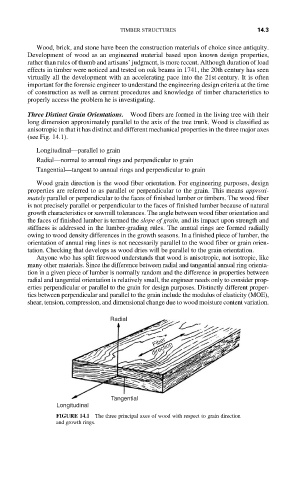Page 512 - Forensic Structural Engineering Handbook
P. 512
TIMBER STRUCTURES 14.3
Wood, brick, and stone have been the construction materials of choice since antiquity.
Development of wood as an engineered material based upon known design properties,
rather than rules of thumb and artisans’ judgment, is more recent. Although duration of load
effects in timber were noticed and tested on oak beams in 1741, the 20th century has seen
virtually all the development with an accelerating pace into the 21st century. It is often
important for the forensic engineer to understand the engineering design criteria at the time
of construction as well as current procedures and knowledge of timber characteristics to
properly access the problem he is investigating.
Three Distinct Grain Orientations. Wood fibers are formed in the living tree with their
long dimension approximately parallel to the axis of the tree trunk. Wood is classified as
anisotropic in that it has distinct and different mechanical properties in the three major axes
(see Fig. 14.1).
Longitudinal—parallel to grain
Radial—normal to annual rings and perpendicular to grain
Tangential—tangent to annual rings and perpendicular to grain
Wood grain direction is the wood fiber orientation. For engineering purposes, design
properties are referred to as parallel or perpendicular to the grain. This means approxi-
mately parallel or perpendicular to the faces of finished lumber or timbers. The wood fiber
is not precisely parallel or perpendicular to the faces of finished lumber because of natural
growth characteristics or sawmill tolerances. The angle between wood fiber orientation and
the faces of finished lumber is termed the slope of grain, and its impact upon strength and
stiffness is addressed in the lumber-grading rules. The annual rings are formed radially
owing to wood density differences in the growth seasons. In a finished piece of lumber, the
orientation of annual ring lines is not necessarily parallel to the wood fiber or grain orien-
tation. Checking that develops as wood dries will be parallel to the grain orientation.
Anyone who has split firewood understands that wood is anisotropic, not isotropic, like
many other materials. Since the difference between radial and tangential annual ring orienta-
tion in a given piece of lumber is normally random and the difference in properties between
radial and tangential orientation is relatively small, the engineer needs only to consider prop-
erties perpendicular or parallel to the grain for design purposes. Distinctly different proper-
ties between perpendicular and parallel to the grain include the modulus of elasticity (MOE),
shear, tension, compression, and dimensional change due to wood moisture content variation.
Radial
Fiber
direction
Tangential
Longitudinal
FIGURE 14.1 The three principal axes of wood with respect to grain direction
and growth rings.

